Remove browser redirects to the geting[.]pro website
Notification SpamAlso Known As: geting.pro pop-up
Get free scan and check if your device is infected.
Remove it nowTo use full-featured product, you have to purchase a license for Combo Cleaner. Seven days free trial available. Combo Cleaner is owned and operated by RCS LT, the parent company of PCRisk.com.
What is geting[.]pro?
geting[.]pro is yet another rogue site that shares many similarities with newsfrog.me, bodlift.com, markably.info, and many others. This website redirects users to other untrustworthy sites and displays dubious content.
Most users arrive at geting[.]pro inadvertently - they are redirected by potentially unwanted applications (PUAs) or intrusive advertisements displayed on other rogue sites. Research shows that most PUAs infiltrate computers without users' consent. As well as causing redirects, they generate intrusive advertisements and track browsing activity.
![geting[.]pro pop-up redirects](/images/stories/screenshots201904/getingpro-homepage.jpg)
Potentially unwanted applications continually open new browser tabs/windows and redirect users to geting[.]pro, which then displays certain content or redirects users elsewhere (or both) - these actions depend on the visitor's geolocation, which is determined by checking the IP address. In any case, users might be presented with malicious content.
Thus, visiting geting[.]pro can lead to system infections. PUAs also deliver intrusive advertisements such as banners, pop-ups, coupons, and similar. They often redirect to dubious websites (gambling, adult dating, pornography, etc.) and, in some cases, run scripts designed to download/install other unwanted, malicious apps.
Therefore, clicking intrusive advertisements might also result in system infections. They are delivered using tools that enable placement of third party graphical content on any site and often conceal underlying content, thereby significantly diminishing the browsing experience.
Another important issue is information tracking. Potentially unwanted applications monitor browsing activity by gathering IP addresses, website URLs visited, pages viewed, search queries, and other similar data.
This data is shared with third parties (potentially, cyber criminals) who generate revenue by misusing private data. Therefore, data tracking can lead to serious privacy issues or even identity theft.
| Name | geting.pro pop-up |
| Threat Type | Push notifications ads, Unwanted ads, Pop-up ads |
| Serving IP Address | 104.28.14.34 |
| Symptoms | Seeing advertisements not originating from the sites you are browsing. Intrusive pop-up ads. Decreased Internet browsing speed. |
| Distribution Methods | Deceptive pop-up ads, potentially unwanted applications (adware) |
| Damage | Decreased computer performance, browser tracking - privacy issues, possible additional malware infections. |
| Malware Removal (Windows) |
To eliminate possible malware infections, scan your computer with legitimate antivirus software. Our security researchers recommend using Combo Cleaner. Download Combo CleanerTo use full-featured product, you have to purchase a license for Combo Cleaner. 7 days free trial available. Combo Cleaner is owned and operated by RCS LT, the parent company of PCRisk.com. |
The internet is full of potentially unwanted applications that share many similarities. By offering "useful functionality", PUAs attempt to give the impression of legitimacy and trick users to install, however, they deliver no real value for regular users.
Most have just one purpose: to generate revenue for the developers. Rather than enabling the functions promised, they cause redirects, deliver advertisements, and gather data.
How did adware install on my computer?
Potentially unwanted applications usually infiltrate computers without users' permission, since developers proliferate them using intrusive advertisements and a deceptive marketing method called "bundling" - stealth installation of third party applications together with regular software.
Developers hide "bundled" applications behind "Custom/Advanced" settings (or other sections) of the download/installation processes.
Furthermore, many users often rush these procedures and skip steps. Additionally, they click various advertisements without understanding the possible consequences. This behavior often lead to inadvertent installation of potentially unwanted applications. The main reasons for computer infections are poor knowledge of these threats and careless behavior.
How to avoid installation of potentially unwanted applications?
To prevent this situation, be very careful when browsing the Internet and downloading/installing software. Bear in mind that developers invest many resources into intrusive ad design, thereby making them seem legitimate. Once clicked, however, they redirect to dubious websites (gambling, adult dating, pornography, and similar).
If you see these ads frequently, uninstall all suspicious browser extensions and applications. Additionally, carefully study each step of the download/installation processes using the "Custom" or "Advanced" settings. Opt-out of additionally-included programs and decline offers to download/install them.
Download apps from official sources only, preferably using direct download links. Third party downloaders/installers often include rogue apps, and thus these tools should not be used. The key to computer safety is caution. If your computer is already infected with rogue applications, we recommend running a scan with Combo Cleaner Antivirus for Windows to automatically eliminate them.
Appearance of geting[.]pro website (GIF)
![geting[.]pro website appearance (GIF)](/images/stories/screenshots201904/getingpro-appearance.gif)
Instant automatic malware removal:
Manual threat removal might be a lengthy and complicated process that requires advanced IT skills. Combo Cleaner is a professional automatic malware removal tool that is recommended to get rid of malware. Download it by clicking the button below:
DOWNLOAD Combo CleanerBy downloading any software listed on this website you agree to our Privacy Policy and Terms of Use. To use full-featured product, you have to purchase a license for Combo Cleaner. 7 days free trial available. Combo Cleaner is owned and operated by RCS LT, the parent company of PCRisk.com.
Quick menu:
- What is geting.pro pop-up?
- STEP 1. Remove spam notifications from Google Chrome
- STEP 2. Remove spam notifications from Google Chrome (Android)
- STEP 3. Remove spam notifications from Mozilla Firefox
- STEP 4. Remove spam notifications from Microsoft Edge
- STEP 5. Remove spam notifications from Safari (macOS)
Disable unwanted browser notifications:
Video showing how to disable web browser notifications:
 Remove spam notifications from Google Chrome:
Remove spam notifications from Google Chrome:
Click the Menu button (three dots) on the right upper corner of the screen and select "Settings". In the opened window select "Privacy and security", then click on "Site Settings" and choose "Notifications".
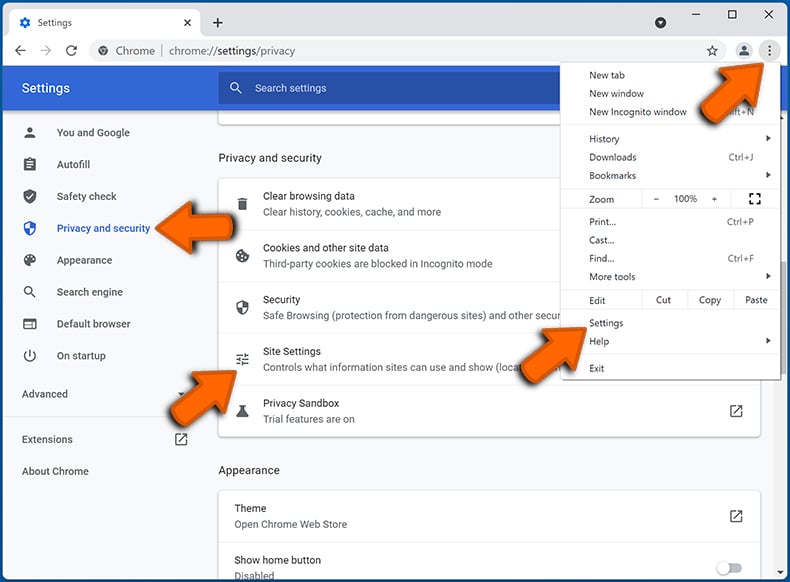
In the "Allowed to send notifications" list search for websites that you want to stop receiving notifications from. Click on the three dots icon near the website URL and click "Block" or "Remove" (if you click "Remove" and visit the malicious site once more, it will ask to enable notifications again).
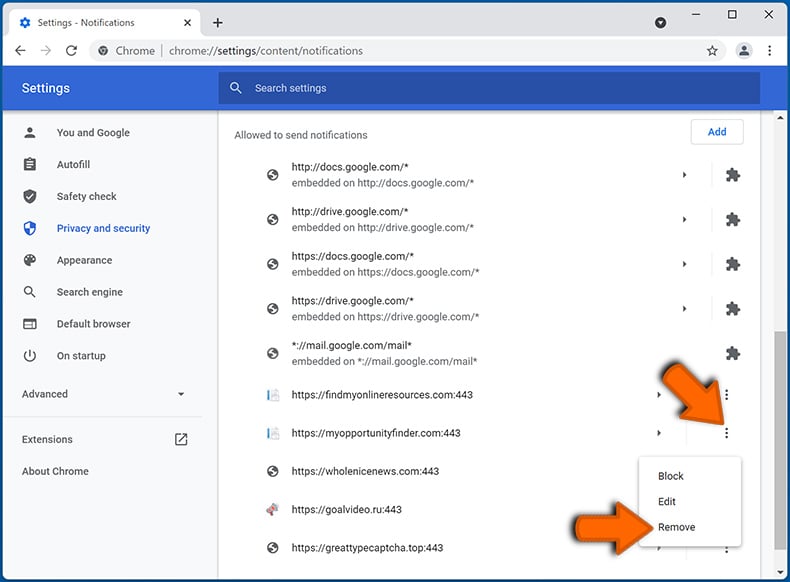
 Remove spam notifications from Google Chrome (Android):
Remove spam notifications from Google Chrome (Android):
Tap the Menu button (three dots) on the right upper corner of the screen and select "Settings". Scroll down, tap on "Site settings" and then "Notifications".
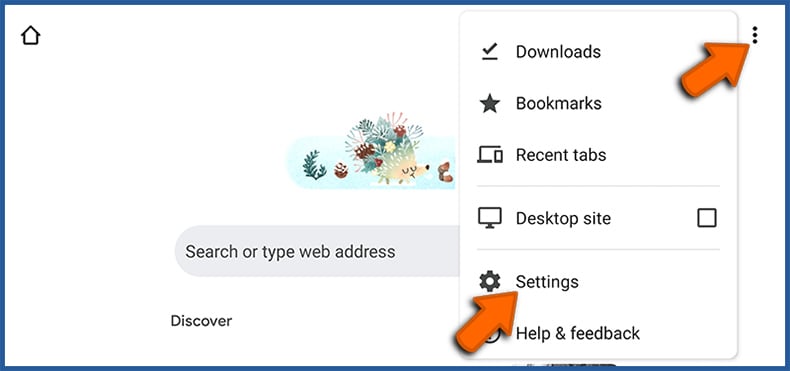
In the opened window, locate all suspicious URLs and tap on them one-by-one. Once the pop-up shows up, select either "Block" or "Remove" (if you tap "Remove" and visit the malicious site once more, it will ask to enable notifications again).
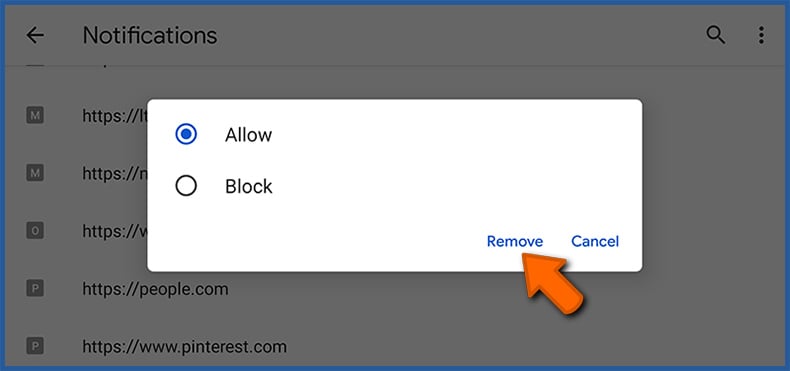
 Remove spam notifications from Mozilla Firefox:
Remove spam notifications from Mozilla Firefox:
Click the Menu button (three bars) on the right upper corner of the screen. Select "Settings" and click on "Privacy & Security" in the toolbar on the left hand side of the screen. Scroll down to the "Permissions" section and click the "Settings" button next to "Notifications".
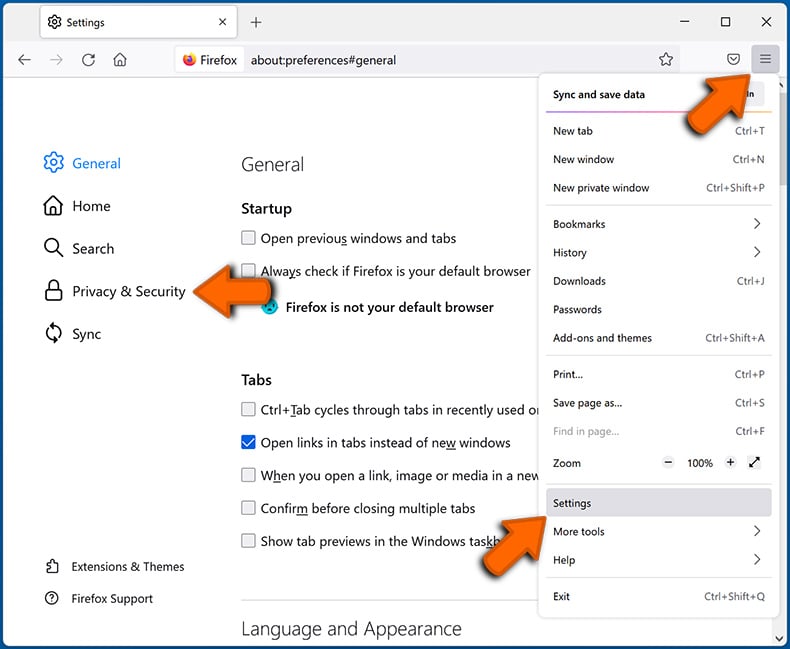
In the opened window, locate all suspicious URLs and block them using the drop-down menu or either remove them by clicking "Remove Website" at the bottom of the window (if you click "Remove Website" and visit the malicious site once more, it will ask to enable notifications again).
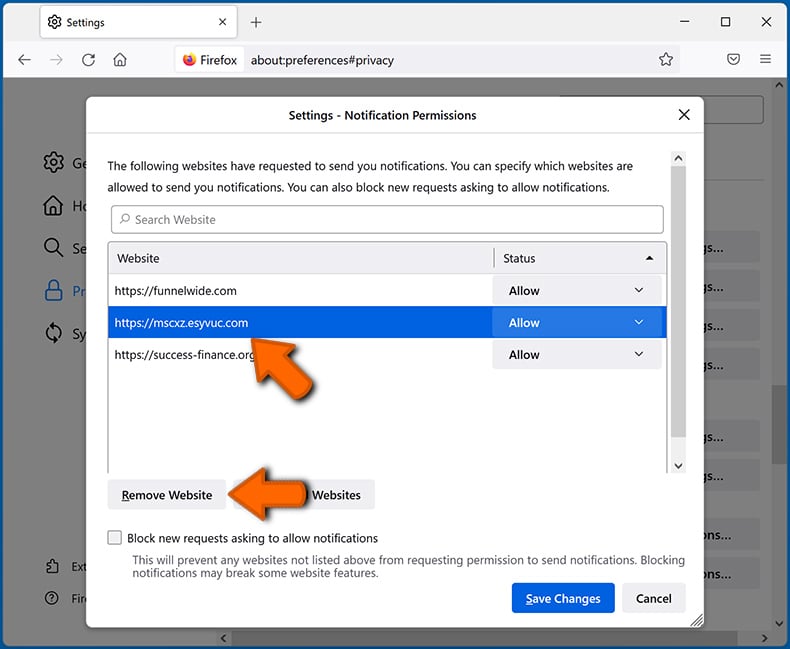
 Remove spam notifications from Microsoft Edge:
Remove spam notifications from Microsoft Edge:
Click the menu button (three dots) on the right upper corner of the Edge window and select "Settings". Click on "Cookies and site permissions" in the toolbar on the left hand side of the screen and select "Notifications".
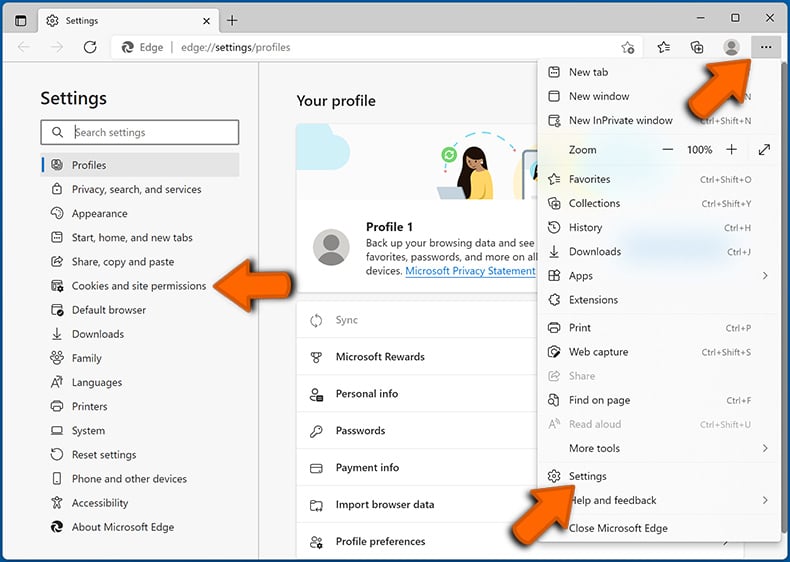
Click three dots on the right hand side of each suspicious URL under "Allow" section and click "Block" or "Remove" (if you click "Remove" and visit the malicious site once more, it will ask to enable notifications again).
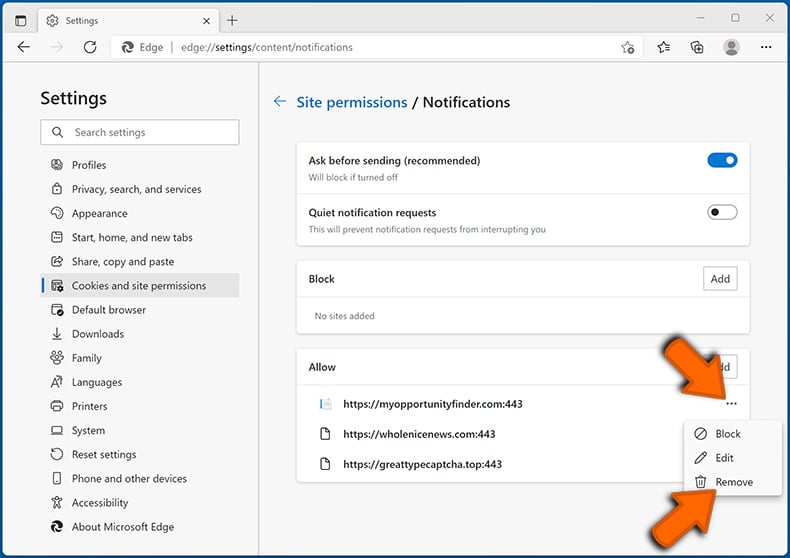
 Remove spam notifications from Safari (macOS):
Remove spam notifications from Safari (macOS):
Click "Safari" button on the left upper corner of the screen and select "Preferences...". Select the "Websites" tab and then select "Notifications" section on the left pane.
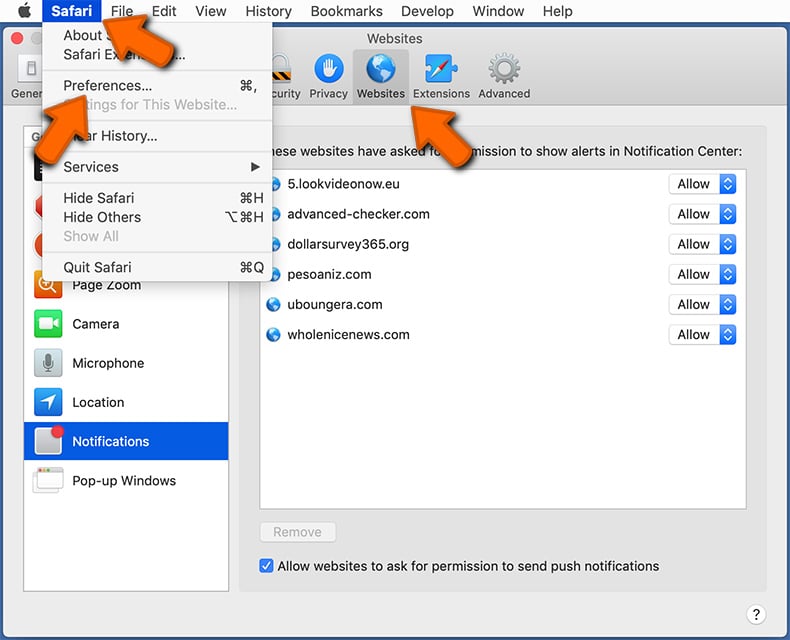
Check for suspicious URLs and apply the "Deny" option using the drop-down menu or either remove them by clicking "Remove" at the bottom of the window (if you click "Remove" and visit the malicious site once more, it will ask to enable notifications again)
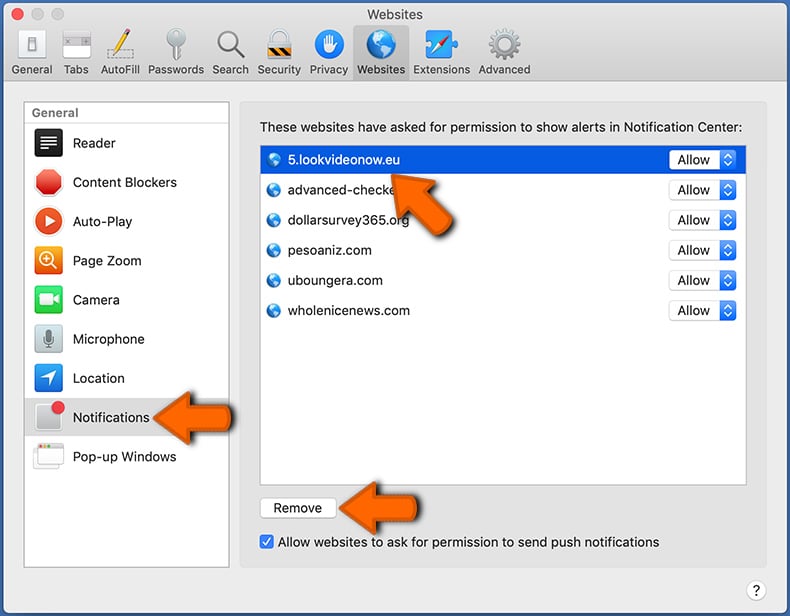
How to avoid browser notification spam?
Internet users should be very skeptical when being asked to allow notifications. While this is a useful feature that allows you to receive timely news from websites you like, deceptive marketers frequently abuse it.
Only allow notifications from websites that you fully trust. For added security - use an anti-malware application with a real-time web browsing monitor to block shady websites that tries to trick you into allowing spam notifications. We recommend using Combo Cleaner Antivirus for Windows.
Share:

Tomas Meskauskas
Expert security researcher, professional malware analyst
I am passionate about computer security and technology. I have an experience of over 10 years working in various companies related to computer technical issue solving and Internet security. I have been working as an author and editor for pcrisk.com since 2010. Follow me on Twitter and LinkedIn to stay informed about the latest online security threats.
PCrisk security portal is brought by a company RCS LT.
Joined forces of security researchers help educate computer users about the latest online security threats. More information about the company RCS LT.
Our malware removal guides are free. However, if you want to support us you can send us a donation.
DonatePCrisk security portal is brought by a company RCS LT.
Joined forces of security researchers help educate computer users about the latest online security threats. More information about the company RCS LT.
Our malware removal guides are free. However, if you want to support us you can send us a donation.
Donate
▼ Show Discussion